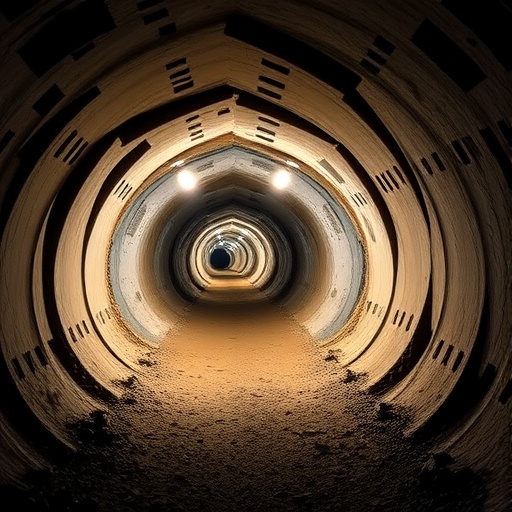In the field of geotechnical engineering and underground construction, understanding the complex stress distribution within tunnels is paramount for ensuring structural safety and longevity. A recent study published in Environmental Earth Sciences sheds new light on the behavior of stress in small clearance tunnels under multifaceted geological and operational conditions. The research, conducted by Chen, Ma, Liu, and colleagues, delves into the intricate ways stresses manifest and propagate in confined underground environments—conditions that have long posed significant challenges for engineers and researchers alike.
The primary focus of this study is to elucidate how stress concentrations develop and evolve within tunnels that feature minimal clearance spaces between the tunnel lining and the surrounding rock or soil. Such small clearance tunnels are often necessitated by practical constraints in urban settings or in complex geological formations where excavation space is limited. The narrow gap introduces unique mechanical interactions between the support structure and the geological medium, often resulting in non-uniform stress distributions that traditional models fail to capture accurately.
Conventionally, tunnel design has relied on simplified assumptions regarding uniform stress fields and stable geological conditions. However, real-world scenarios often involve heterogeneities such as layered rock formations, variable groundwater pressures, and dynamic loadings from adjacent infrastructure. Chen and colleagues incorporated these variables into their analysis, developing a sophisticated simulation framework that combines numerical modeling with empirical validation techniques. This approach provides a more realistic representation of the tunnel environment and its mechanical responses.
At the heart of their methodology is the use of advanced finite element modeling which incorporates non-linear material behavior, anisotropic stress fields, and multi-axial loading conditions. The researchers meticulously calibrated the model parameters based on in-situ measurements and laboratory tests on rock samples. This comprehensive calibration enables the accurate depiction of stress concentration zones, especially around critical points such as the crown, springline, and invert of the tunnel cross-section, where the risk of failure is highest.
The study reveals that stress distributions in small clearance tunnels are highly sensitive to both geological and excavation-induced factors. Variations in rock stiffness and the presence of discontinuities such as faults or joints can significantly alter stress pathways, leading to localized stress intensifications. Moreover, changes in groundwater levels were found to induce transient stress fluctuations, which, if not accounted for, could precipitate premature lining deformations or even collapse.
One particularly novel aspect of the research is the investigation of stress redistribution during progressive excavation phases. As tunneling advances, the interaction between the excavation face, support systems, and the rock mass evolves dynamically. Chen et al. observed that stress waves generated by excavation activities propagate ahead and around the tunnel perimeter, creating zones of stress accumulation and release that vary temporally and spatially. Understanding this dynamic interplay is crucial for optimizing support installation schedules to mitigate risk.
The implications of these findings stretch beyond theoretical modeling. In practical terms, the insights can inform improved tunnel design protocols that proactively accommodate complex geological and operational variables. For instance, support structures might be tailored to specific stress concentration zones identified by the model, deploying customized reinforcement strategies rather than uniform supports. Such targeted interventions can enhance both safety and cost-effectiveness.
In addition to static load considerations, the study addresses dynamic stresses induced by machinery vibrations, seismic events, and nearby traffic. These dynamic components particularly affect small clearance tunnels, where limited space restricts the ability of the tunnel lining to absorb and distribute stresses elastically. The researchers demonstrated that incorporating dynamic loading into design criteria helps prevent cumulative damage mechanisms, such as fatigue cracking and joint slippage, which otherwise compromise tunnel integrity over time.
Complementing the numerical analysis, field experiments conducted at several test sites validated the theoretical stress predictions. Instrumentation arrays installed within existing tunnels provided real-time monitoring data on strain, displacement, and pore pressure variations. The strong correlation between observed data and simulated outcomes underscores the robustness of the proposed model and its applicability in operational settings.
Furthermore, Chen and collaborators explored the effects of various support materials—including shotcrete, steel ribs, and composite linings—on stress field modulation. The results suggest that material choice and installation methods play a pivotal role in adjusting stress concentrations, highlighting the need for integrated design approaches that consider both geological and engineering factors in tandem.
The research also calls attention to the critical role of groundwater management in tunnel stability. Hydrological variations influence effective stress states within the surrounding rock, impacting both the magnitude and distribution of stresses around the tunnel. Strategies combining drainage systems with stress-relief structures can synergistically stabilize small clearance tunnels, a factor particularly relevant in regions with fluctuating groundwater regimes.
Looking ahead, the study lays a foundation for more interdisciplinary research linking geomechanics, hydrology, and construction technology. It encourages the development of adaptive tunnel monitoring systems that leverage machine learning techniques to predict stress evolution and potential failure points, thereby enhancing real-time decision-making during excavation and operation.
In essence, this work represents a significant stride toward mastering the mechanical complexities inherent in small clearance tunnel construction under multifarious and challenging conditions. By transcending simplified assumptions and embracing the heterogeneous realities of underground environments, the study equips engineers with sophisticated tools to design safer, more resilient subterranean infrastructure.
As urbanization accelerates and demand for underground transportation and utility corridors increases, the relevance of refined stress distribution knowledge grows ever more critical. Studies like this, bridging theoretical geomechanics with practical engineering challenges, pave the way for safer and more sustainable underground construction practices worldwide.
This landmark investigation, published in 2025, thus offers not only fresh academic insights but also actionable engineering advancements that could redefine small clearance tunnel design standards and operational protocols globally.
Subject of Research: Stress distribution characteristics in small clearance tunnels under complex geological and operational conditions.
Article Title: Study on stress distribution characteristics in small clearance tunnels under complex conditions.
Article References:
Chen, J., Ma, S., Liu, A. et al. Study on stress distribution characteristics in small clearance tunnels under complex conditions. Environ Earth Sci 84, 636 (2025). https://doi.org/10.1007/s12665-025-12617-2
Image Credits: AI Generated




